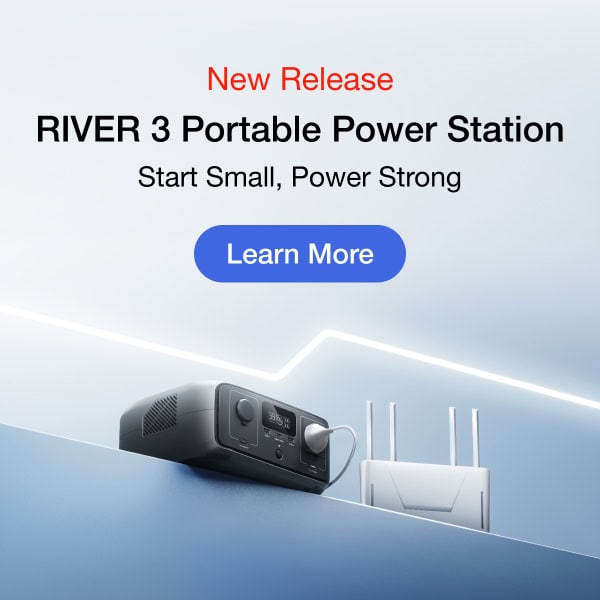Off-grid living frees you from dependence on the traditional electricity grid. Batteries play a crucial role in living off-grid, allowing you to store electricity for later use. Without batteries, off-grid living using primarily clean energy for your electricity needs would be difficult, as there would be no way to store the power produced by renewable energy sources like solar and wind power.
Several types of batteries are used for off-grid living: lithium-ion batteries, lithium iron phosphate, lead acid, and nickel-cadmium. Each type of battery has its strengths and limitations. Choosing the correct type of battery is crucial for ensuring a reliable off-grid solar power system.
Solar Battery Voltage
The most common type of off-grid battery is a solar battery, with options for 12V, 24V, or 48V. The voltage you choose for your batteries will affect the rest of your system.
The standard vehicle uses 12V batteries. It’s sufficient for recharging solar batteries and makes it easy to use your vehicle as a backup charging source.
The size up from 12V is 24V, commonly used for larger vehicles, such as trucks and busses. Many motorhomes and boats also use this voltage.
48V batteries are not necessarily bigger. Instead, they produce the same amount of power as 12V but in a more compact solution. 48V batteries, like the ones used in EcoFlow Power Kits, operate more efficiently, reducing power loss and heat output.
Off-Grid Battery Types
Off-grid batteries that allow you to run your appliances and electronics free of the grid come in several different compositions. Here are the most common.
Lithium Ion Batteries
Lithium-ion batteries are a type of rechargeable battery commonly used in electronic devices, such as laptops and cell phones. They’re also used in many residential solar systems and electric vehicles.
One of the main advantages of lithium-ion batteries is their high energy density, which means they can store a lot of energy in a small space. The compact size makes them a good choice for applications where weight and size are essential.
Lithium-ion batteries also have a long lifespan, typically at least five years, with some models lasting up to 20. They don’t suffer from the “memory effect,” which affects the battery’s ability to recharge over time. In addition, they are relatively low maintenance.
Historically, lithium batteries were expensive to manufacture. Due to their recent surge in popularity and widespread use, their cost has decreased.
Lithium Iron Phosphate (LiFePO4)
Recent innovations in battery technology have produced a new type of cell chemistry: lithium-iron phosphate batteries (commonly known as LFP or LiFePO4). LFP batteries are found in EcoFlow’s current range of portable power stations, solar generators, and Power Kits.
LFP batteries aren’t the same as lithium-ion batteries. Lithium-ion batteries traditionally use cobalt, but lithium iron phosphate batteries use a combination of iron phosphate and graphite. The cobalt in lithium-ion batteries in electric vehicles is toxic, making the LiFePO4 batteries a more environmentally friendly alternative. Additionally, over 70% of the world’s cobalt comes from the Democratic Republic of Congo (DRC), mined under extremely harsh conditions and often using child labour.
LFP batteries are typically more efficient for storage, have longer lifespans, and operate in a broader range of temperatures without diminished performance.
LiFePO4 (LFP) batteries are the best choice for off-grid living. They’re more efficient with faster charging, a longer life cycle, and less environmental impact.
Lead Acid Batteries
lead acid batteries are rechargeable and use lead and lead oxide as electrodes and sulfuric acid as the electrolyte. They are common in cars, golf carts, boats, and similar applications.
Lead acid batteries are relatively inexpensive and widely available, making them a cost-effective choice. Additionally, they can withstand deep discharges without suffering damage.
On the other hand, they’re heavy, bulky, and inefficient — and are rarely used in modern off-grid solar power systems. Lead acid batteries typically require frequent maintenance, such as filling them with water. In addition, lead acid batteries have a relatively low energy density. They cannot store as much energy in a given space.
A few common variations of lead acid batteries are worth noting.
Flooded Lead Acid
Flooded lead acid batteries use liquid electrolytes, typically a mixture of sulfuric acid and water. The term “flooded” refers to the battery cells being filled with electrolytes, which are not sealed inside the battery.
Flooded lead acid batteries are the most common type of lead acid battery. They are relatively inexpensive and have an average lifespan of three to five years.
One of the main advantages of flooded lead acid batteries is the ease of maintenance. Users can open the battery to check the electrolyte level and replenish it as needed. However, this means that flooded lead acid batteries require regular maintenance.
Flood lead acid batteries can also produce hydrogen gas, which can be explosive if it accumulates in an enclosed space.
Gel Lead Acid
Gel lead acid batteries use a thick, jelly-like electrolyte mixed with a silica gel, which helps to suspend the sulfuric acid and prevent it from spilling.
Gel lead acid batteries are more expensive than flooded lead acid, but they have several advantages. They are sealed and do not produce hydrogen gas, so they’re safer to use in enclosed spaces. They also do not require as much regular maintenance, such as adding water to the cells to replenish the electrolyte.
Gel lead acid batteries are well-suited for applications where the battery is installed in an inverted or tilted position, as they are less prone to leakage than flooded lead acid. They are also more resistant to vibration and shock, making them a more suitable lead acid choice for recreational vehicles and boats.
However, they are not as energy-dense as other battery types, meaning they cannot store as much energy in a given space. They also have a relatively high self-discharge rate, so they can lose their charge even when not in use.
AGM Lead Acid
Absorbed Glass Mat (AGM) lead acid uses a fibreglass mat to absorb the electrolyte sandwiched between the battery’s electrodes. It serves to separate them while allowing ions to pass through.
AGM lead acid is more expensive than the flooded variation, but they are sealed and do not produce hydrogen gas. They do not require regular maintenance. However, they also have issues with energy density and a high self-discharge rate.
Nickel Cadmium Batteries
Nickel-cadmium (NiCad) batteries use nickel oxide and cadmium as the electrodes and potassium hydroxide as the electrolyte. They are commonly used in portable electronic devices, such as power tools and cordless phones.
NiCad batteries are well-suited for applications that require a durable and long-lasting power source, as they have a long lifespan and are resistant to abuse. They are also a good choice for applications where the battery will be used in cold temperatures, as they have a relatively low discharge rate at low temperatures.
However, they are not as energy-dense as lithium-ion or LFP batteries, meaning you will need more to store the same amount of energy. They are also prone to the “memory effect” phenomenon, which means they “remember” their previous discharge cycles and won’t recharge fully.
In addition, NiCad batteries contain cadmium, which is toxic and can be harmful to the environment. This type of battery is rarely used in solar power systems.
Conclusion
Lithium iron phosphate (LFP) is the best option for most off-grid situations. They have a high energy density, meaning they can store ample energy in a small space. They are also lightweight and have a long lifespan. In addition, they do not suffer from memory effects and do not require maintenance (such as adding water to the cells).
While they are more expensive upfront than other types of batteries, their small size, low maintenance, and long lifespan make them a cost-effective choice. If you’re building an off-grid Smart Home EcoSystem, you want an efficient and lasting solution. LiFePO4 (LFP) batteries are the best choice to achieve those goals.





